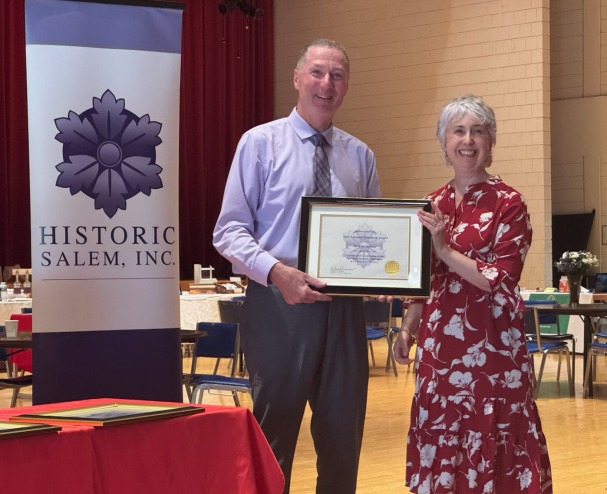| Contact |
Dustin Luca
|
|---|

SALEM, MASS. – When Lisa Delissio walks the paths throughout Greenlawn Cemetery, she sees more than a natural property enjoyed by many. She sees 55 acres of history, an army of volunteers, and close to a century of efforts coming together to preserve one of Salem’s stand-out natural resources.
Delissio, a biology professor at Salem State, has been honored with a preservation award from Historic Salem, Inc. (HSI) for her leadership in documenting and preserving the F. Carroll Sargent Arboretum at Greenlawn Cemetery. She has spent the past five years collaborating with community partners and students to inventory and revitalize the arboretum, which received international ArbNet accreditation through a process she led in 2020.
The recognition from HSI celebrates not only Delissio’s expertise in the field, but the collective effort of Salem residents, Salem State faculty, and more than 100 students—all combining for what she described as “an army of volunteers” that have kept the project going.
“I was surprised, because I didn’t know I was nominated,” Delissio said. “Really, this has been an egalitarian, collaborative project from the beginning. It’s gratifying to see the work of our students, volunteers, community, and city partners recognized, and to gain more visibility for the project.”
Rediscovering history
Greenlawn Cemetery, established in 1807, is a working cemetery and celebrated walking destination for North Shore residents going back generations. It has been home to the arboretum since it was created during the New Deal in the mid-1930s and then into the 1940s, when vast amounts of planting took place to ornament the cemetery with species of trees and shrubs from around the world.
Despite the intense work to establish the arboretum close to a century ago, records of the plantings are incomplete.
“The only remaining records of the community plantings was a list from 1942, typed from a typewriter with no maps,” Delissio said. “That means in order to not just appreciate what’s there but understand it, there is a rediscovery process where we need to re-inventory all the trees and shrubs that are there.”
That’s where the army of volunteers comes in. Since 2020 and continuing today under Delissio’s guidance, city volunteers and Salem State students have been carrying out the first modern inventory of Greenlawn—digitally mapping the property, tagging trees, and even analyzing tree DNA to unlock historic biodiversity.
“Crabapples are really hard to identify from their physical characteristics, and the 1942 list includes species of crabapples that the U.S.D.A. doesn’t have in their collection,” Delissio said. “So, we plan to use DNA to identify them. These trees that likely have survived for more than 80 years have some potentially interesting resistance to pests and pesticides, for example.”
A community of support
The project has drawn on expertise across disciplines at Salem State, with more than 100 students involved in hands-on fieldwork, from botany and soil testing to mapping tree canopy cover by drone and studying Greenlawn’s architecture and art.
For that, the community has given back: on Saturday, Sept. 6, HSI awarded Delissio with a Nathaniel Bowditch Award for her work to preserve and restore history at Greenlawn Cemetery.
Richard Lindeman, president of HSI, said that “Dr. Delissio’s leadership in Salem ensures the botanical legacy of the Sargent Arboretum at Greenlawn Cemetery will educate not only residents in Salem and on the North Shore, but also future students at Salem State University and across the Commonwealth.”
Christine Lutts, president of Friends of Greenlawn Cemetery, said Delissio is “an instrumental part of the F. Carroll Sargent Arboretum at Greenlawn Cemetery collaboration.”
“Her vast knowledge, student involvement and absolute support of this amazing 55-acre historic, accredited arboretum is greatly appreciated and so important,” Lutts said. “The Friends of Greenlawn is grateful to have her as our partner in the work that is being done to catalog the arboretum inventory and learn about the possible collections of trees and shrubs there while continuing to enhance and protect Salem’s historic arboretum.”
